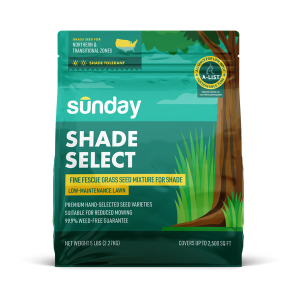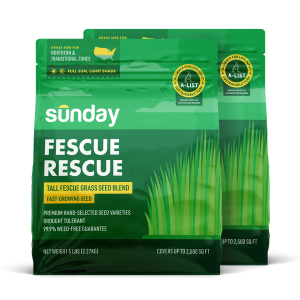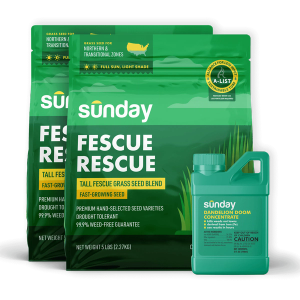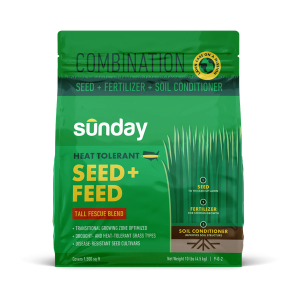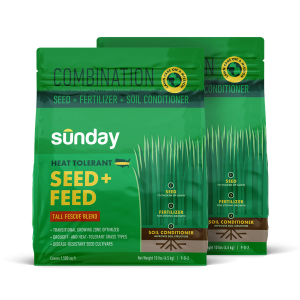Lawn culture
When you think of “all-American,” what comes to mind? Perhaps apple pie, stars and stripes, and of course, backyard barbecues. A green lawn is a cornerstone of the American dream—and keeping it maintained is a huge part of our daily lives. So much so that over 75 percent of us participate in DIY lawn and garden care! It’s part of our culture, and a pillar in our weekend ritual.
Lawns in the United States
In the U.S., we pride ourselves on having lush, well-maintained lawns, and we really value them. Just look at the number of HOAs that require upkeep, or peek around at the devices in your friends' hands. 100 million Americans have an iPhone, and roughly 180 million have a lawn—which means that around here, you’re more likely to have a lawn than an iPhone. Since 1980, the number of lawns in the U.S. increased by 30 percent—and at $48 billion, the DIY lawn and garden market is a behemoth that continues to grow.
While your little lawn may not seem like much to you, all of our little lawns really add up. At 40 million acres (and growing), the combined size of our lawns dwarfs that of our national parks, organic farms, and Massachusetts—combined.
A toxic landscape
With the sheer amount of land that our lawns take up, it’s important that the land remains healthy. But, believe it or not, some of the most polluted land in the U.S. may be yours. Some of the highest concentrations of pesticides can be found close to home—right in the backyard.
So how did we get here? By relying on a lazy, brute-force approach to lawn care. Think of it like this: You wouldn’t fog your house with Lysol three times a year, but that’s close to what’s happening on lawns. Instead of treating specific issues when and where they occur, we cover our entire property in toxic pesticides at rates far higher than are used on industrial farms. In fact, one leading lawn care company recommends four (!) full-property pesticide applications per year. We get it, this may feel more convenient than spot treatments. But by applying pesticides preventively—when in most cases they are not needed at all—we’re seriously mistreating our lawns. And the planet.
More on excessive pesticide use
“Pesticide” is a blanket term for herbicides (weed control), fungicides (disease control), and insecticides (insect and insect-like pest control). We’ve fallen into a habit of misusing—and overusing—them so much that fully 75 percent of all U.S. households use pesticides. That adds up to 90 million pounds per year—five times more per acre than industrial farms. And it doesn't all just stay on the lawn.
When it’s on your lawn, it’s in your water
The pesticides we use on lawns, gardens, and in agriculture are also found in our water. A study conducted by the U.S. Geological Survey found that 19 of the most commonly used lawn pesticides were found in a groundwater, and The Cornell University Cooperative Extension states “cleanup of groundwater contaminated by pesticides is often impossible.”
When it’s on your lawn, it’s in your home
The harsh truth is that if you could see pesticides, you’d see them everywhere. A recent Cornell study tested homes for the presence of 15 potentially toxic pesticides and found all 15 in every home they tested. And there isn’t an easy solution for correcting this problem. The EPA states that pesticides that are tracked-in or blown indoors take longer to break down, contributing to the mind-bending fact that 80 percent of pesticide exposure happens indoors.
When it’s on your lawn, it’s in your body
If pesticides are in your water, and in your home, it’s safe to assume they’ve made it into your body, too. Glyphosate was found in the urine of 93 percent of Americans in a study carried out by UC San Francisco. Similarly, in a study performed by the National Exposure Research Lab, 2,4-D, used in the most popular weed & feed products, was found in 85 percent of urine samples from child and adult participants.
Risk vs. benefit
Given the obvious risk that pesticides are posing to our bodies and ecosystems, you’re probably wondering why we do all this. Is there some result that makes the risk to our planet and health worth it? The short answer: no. Long answer? Still no—and all of this is mostly about killing dandelions. Yep, those wistful little puffballs we wished on as children got villified in the pursuit of one-upping our neighbors.
For what it's worth, we totally understand the desire to have a perfect lawn. Compliments feel good! But you don’t need to resort to poisoning your property to make it happen. That’s where we come in. Sunday customers have beautiful lawns powered by simple ingredients you can feel good about. Need proof? Check out our reviews.
A bright future for our backyards
There’s no reason your lawn can’t look great and do good at the same time. By working with nature, instead of attempting to dominate it, you can grow a beautiful lawn that gives back more than it takes.
Your backyard can be a rich ecosystem, full of butterflies and birds. It can help fight climate change by pulling carbon dioxide right out of the air. It can be your sanctuary—a place to relax and play without compromise. It’s your little plot of land, and Sunday can help you make it a place you feel more than a little good about!
Cited sources
2012-2016 American Community Survey 5-Year Estimates Factfinder. U.S. Census Bureau.
2016 Certified Organic Survey. United States Department of Agriculture (USDA).
2019 National Gardening Survey. Gardenresearch.com.
Acerage (June 2019). United States Department of Agriculture (USDA).
Adult and children’s exposure to 2,4-D from multiple sources and pathways. Journal of Exposure Science & Environmental Epidemiology.
Biogeochemical cycling of carbon and nitrogen in cool-season turfgrass systems. Science Direct.
Common Pesticide Residues in Rural Homes of New York State. JSM Health Education and Primary Health Care 3(1): 1042.
Exposure to Glyphosate, Chemical Found in Weed Killers, Increased Over 23 Years. UC San Diego.
Historical Census of Housing Tables. U.S. Census Bureau.
Lawn and garden retail outlet total sales in the United States from 2009 to 2017. Statista.
Mapping and Modeling the Biogeochemical Cycling of Turf Grasses in the United States. Journal of Environmental Management.
Pesticide Exposure and Child Neurodevelopment. Journal of Workplace Health & Safety.
Pesticides and Groundwater: A Guide for the Pesticide User. Natural Resources Cornell Cooperative Extension Fact Sheets.
Pesticides Industry Sales and Usage: 2008 and 2012 Market Estimates. U.S. Environmental Protection Agency (EPA).
Pesticides’ Impact on Indoor Air Quality. The United States Environmental Protection Agency (EPA)
Scotts Program Home Page. 2020.
Share of smartphone users that use an Apple iPhone in the United States from 2014 to 2021. Statista.
USA Average Household Size. ArcGIS.
Toxic Fairways: Risking Groundwater Contamination from Pesticides on Long Island Golf Courses. Handbook of Pest Management in Agriculture, National Research Council.
The quality of our Nation’s waters—Water quality in Principal Aquifers of the United States, 1991–2010. U.S. Geological Survey Circular 1360.
What’s Happening to the Frogs? U.S. Fish and Wildlife Service Kicks-off Nation-wide Scientific Study of Refuges to Determine Cause of Frog Deformities. News Release. 00-113.








